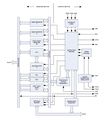MOS Technology 6502: Difference between revisions
No edit summary |
No edit summary |
||
| Line 81: | Line 81: | ||
==Used in== | ==Used in== | ||
* [[1230]], [[1225]], [[1220]] | * [[1230]], [[1225]], [[1220]] (65C02) | ||
* [[DC509]], [[DC5009]]: R6504 28-pin DIP variant with 13-bit address bus (8K address space) | * [[DC509]], [[DC5009]]: R6504 28-pin DIP variant with 13-bit address bus (8K address space) | ||
* [[DC5010]] | * [[DC5010]] | ||
Revision as of 09:54, 5 March 2022

The MOS Technology 6502 is an 8-bit processor introduced in 1975 that was originally developed by a team led by the engineer Chuck Peddle at MOS Technology (later purchased by Commodore).
It was second-sourced by other companies such as California Micro Devices (GTE Microcircuits), Rockwell, and Synertek. Western Design Center (WDC) first developed a CMOS version, which is still in production as of 2019. In addition, several implementations (commercial as well as free) are available to synthesize the core into FPGA designs.
The 6502 was a popular choice of processor because of its low price and high capabilities. It was used in multiple early computers such as the Commodore 64, Commodore VIC-20, Apple II, BBC micro, and many others.
Internals
The 6502 had many revisions and derivatives. Most of the revisions have either enhanced its capabilities or have added new features.
Depending on the manufacturer, the fabrication process can be CMOS, HMOS and NMOS.
The 6502 has three registers, one main register and two index registers. The original MOS 6502 had 151 "legal" opcodes. Later version included more.
| MOS 6502 registers | |||||||||||||||||||||||||||||||||||||||||||||||||||||||||||||||||||||||||||||||||||||||||||||||||||||||||||||||||||||||||||||||||||||||||||||||||||||||||||||||||||||||||||||||||||||||||||
| |||||||||||||||||||||||||||||||||||||||||||||||||||||||||||||||||||||||||||||||||||||||||||||||||||||||||||||||||||||||||||||||||||||||||||||||||||||||||||||||||||||||||||||||||||||||||||
Used in
- 1230, 1225, 1220 (65C02)
- DC509, DC5009: R6504 28-pin DIP variant with 13-bit address bus (8K address space)
- DC5010
- ...
Supported by
Links
- WDC 65C02 datasheet (Offsite)
- 6502 information site including datasheets and other derivative processors
- Wikipedia: MOS Technology 6502

